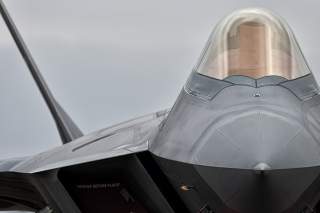Stealth F-22 Raptors Have Left the Middle East: What You Need To Know
After five years of continuous operations, U.S. Air Force F-22 Raptors stealth fighters have left the Middle East. Older F-15C fighters have taken their place.
It's unclear when, or if, F-22s will return to the Middle East. AFCENT celebrated the arrival of the replacement F-15Cs in a Feb. 23, 2019 photo-essay. "The tactical fighters are deployed to the U.S. Central Command’s area of responsibility to provide stability in the region," the command stated.
After five years of continuous operations, U.S. Air Force F-22 Raptors stealth fighters have left the Middle East. Older F-15C fighters have taken their place.
The Air Force had little choice but to withdraw the radar-evading Raptors. The flying branch is struggling to rebuild the tiny and stressed F-22 force following the destruction of Tyndall Air Force Base, once the home of scores of Raptors, in Hurricane Michael in October 2018.
The Pentagon's 2018 edict to boost fighter readiness to 80 percent in 2019 also weighs on the 186-strong Raptor fleet. As of late 2018, the F-22 force reported a 50-percent mission-capable rate. Bringing the Raptors home could help airmen to affect repairs that could improve the reliability of the overall fleet.
"There are currently no F-22s deployed to AFCENT, but the United States Air Force has deployed F-15Cs to Southwest Asia," U.S. Air Forces Central Command told Air Force magazine.
AFCENT downplayed the significance of the move. "U.S. Air Force aircraft routinely rotate in and out of theater to fulfill operational requirements, maintain air superiority and protect forces on the ground."
"For years, the air superiority role had been flown by F-22s, which first deployed for combat in 2014 in support of the anti-ISIS fight," Brian Everstine wrote in Air Force.
The Air Force has touted the Raptors as a “quarterback” for strike operations in a complex area that includes anti-aircraft threats from the Syrian military, as well as Russian aircraft operating in the region.
F-22s also have conducted their own air strikes, and escorted USAF bombers on high-profile strike missions in Syria, such as the April 2018 mission targeting Syrian president Bashar Al Assad’s chemical weapons infrastructure, after the regime allegedly used chemical weapons on a suburb of the country’s capital.
"Thanks to its unique fifth-generation capabilities, the F-22 was the only airframe suited to operate inside the Syrian integrated air defense systems, offering an option with which to neutralize [integrated air-defense system] threats to our forces and installations in the region, and provide protective air support for U.S., coalition and partners on the ground in Syria," AFCENT told Air Force following the April 2018 strike.
The F-22 crews returning from the Middle East came home to a very different environment than the one they left.
Prior to Hurricane Michael in October 2018, two squadrons at Tyndall -- the 43rd Fighter Squadron, which is a training unit, and the combat-coded 95th Fighter Squadron -- together operated 55 F-22s.
Michael wreaked havoc on the base, uprooting trees, flattening buildings and ripping the roofs off of hangars.
Tyndall airmen were able to fly out just 38 of the 55 Raptors prior to the storm. The remaining 17 jets -- nearly a tenth of all F-22s -- rode out the wind and rains in hangars. Some suffered damage.
Airmen quickly repaired many of the jets. Official photos depicted small numbers of F-22 departing Tyndall on Oct. 21 and 24, 2018. The last three F-22s left Tyndall on Nov. 16.
With Tyndall likely to need years of work costing billions of dollars, the Air Force announced that all F-22s would relocate to other bases. The 43rd Fighter Squadron, the training unit, set up shop with 28 F-22s at Eglin Air Force Base in western Florida.
That's three fewer F-22s than the squadron possessed prior to the storm, implying that at least three Raptors suffered storm damage requiring long-term repairs.
The combat-coded 95th Fighter Squadron meanwhile dispersed its own F-22s to the three other bases with front-line Raptors. "We have recommended that the best path forward to increase readiness and use money wisely is to consolidate the operational F-22s," Air Force Secretary Heather Wilson said.
Langley in Virginia, Elmendorf in Alaska and Hickam in Hawaii together house five F-22 squadrons. At the time of the storm, Langley's two squadrons each had 23 F-22s. Elmendorf's two squadrons together possessed 47 Raptors. Hickam's sole squadron, an Air National Guard unit, operated 20 F-22s.
Spreading the 95th Fighter Squadron's 24 F-22s across the other five units would allow the surviving units to maintain 24 jets of their own, Air Force Times reported. In fact, the five squadrons between them needed just seven extra Raptors to boost their inventories to 24 planes apiece.
The redistribution of Raptors into fewer but larger squadrons, while potentially disruptive in the short term, ultimately could help maintainers to improve their readiness rate. "Larger, traditional Air Force squadrons and deployable units provide a better balance of equipment and personnel," the Government Accountability Office explained.
"The reason is the economy of scale," Air Combat Command boss Gen. Mike Holmes told Air Force's Everstine. "If on any given day you only want to commit a certain percentage of your aircraft to the flying schedule, and spend time addressing delayed discrepancies, doing planned and unplanned maintenance on the others. The more you have, the more you can commit a certain percentage of them [to maintenance], … the more sorties you have to train pilots."
It's unclear when, or if, F-22s will return to the Middle East. AFCENT celebrated the arrival of the replacement F-15Cs in a Feb. 23, 2019 photo-essay. "The tactical fighters are deployed to the U.S. Central Command’s area of responsibility to provide stability in the region," the command stated.
David Axe serves as Defense Editor of the National Interest. He is the author of the graphic novels War Fix, War Is Boring and Machete Squad.
Image: Creative Commons.

